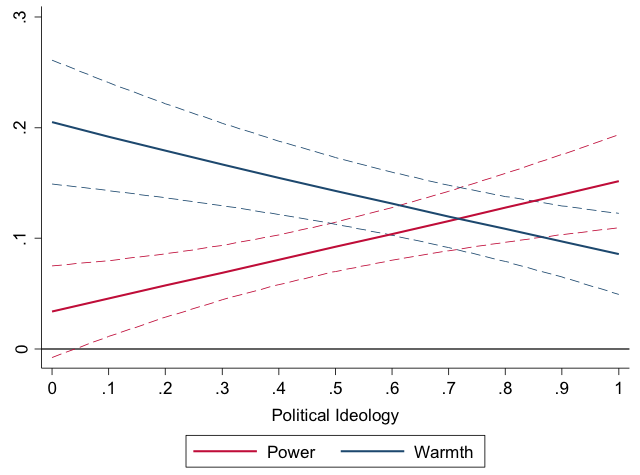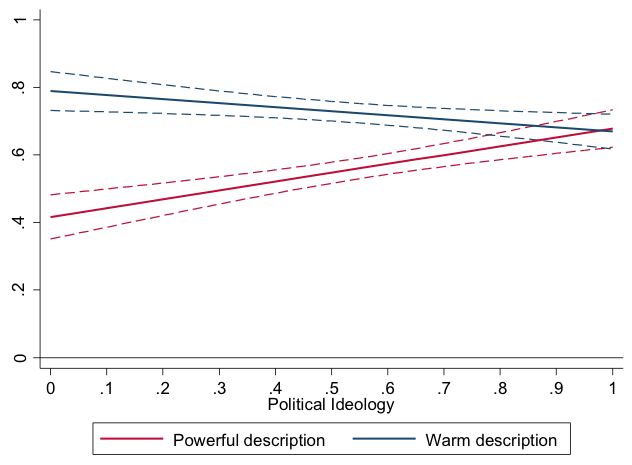Powerful or warm? Liberal and conservative voters favour different traits in a politician
A politician’s personality has always been important to voters. Lasse Laustsen (Aarhus University) carried out analyses of American and Danish data to find out which character traits most appeal to liberal and conservative voters. Liberals – who take a more benevolent view of human co-operation – tend to prefer warm, co-operative individuals; conservatives, mindful of the threats they face, like dominant, uncompromising leaders.

Barack Obama at a community centre in Kansas, 2015. Photo: Obama White House/ Pete Souza. United States government work
Several decades of research in political and electoral behaviour have concluded that a candidate’s personality matters when voters cast their ballots. Unsurprisingly, the main take-away from most of these studies is that voters tend to vote for candidates that they find appealing. However, existing research is still unclear about the specific types of candidate personalities and character traits voters find most appealing. In a recently published article, I build on the growing interest in the deep-seated psychological differences between liberal and conservative voters to argue that ideological orientation has a significant effect on which character traits voters prefer.
Ideology colours how we perceive the social world
Prior research has provided extensive evidence that voters subscribing to a liberal or a conservative ideology, respectively, are not just politically different. They also have different personality profiles and different tastes when it comes to interior design, food and music. These differences lead liberals and conservatives to hold very different perceptions of the social world and, therefore, they differ over which of the problems facing society are most urgent. Specifically, while conservative voters tend to perceive the social world as dangerous, threatening and competitive, liberal voters see it as relatively more peaceful and characterised by cooperation. Compared to liberals, conservatives tend to focus more on external threats – e.g., terror, immigration and foreign powers – as well as on internal threats stemming from criminals and norm violators.
Based on these well-established differences between voters from the two opposing ideological camps, I hypothesised that conservatives and liberals should also prefer different character traits in political candidates. Specifically, I expected that conservative and liberal voters would prefer traits that match their more general perceptions of the social world: conservatives should put greater emphasis on traits related to “power” and “strong leadership” than liberals, who on the other hand should draw more on traits such as “compassion” and “empathy” than conservatives do. I tested this hypothesis using The American National Election Study (ANES) and two experiments conducted among Danish students and representative Americans.
Test 1: American Presidential Elections 1984-2008
To test my hypothesis, I took advantage of American voters’ trait perceptions of the two main contenders for the US presidency as measured in the ANES. Specifically, using four-point scales from “not well at all” to “extremely well”, ANES respondents rated how well each of the following traits describe a specific candidate: Strong leader, empathetic, compassionate, intelligent and knowledgeable. Here I used “strong leadership” to capture impressions of the candidates as powerful. Likewise, I created a composite measure of warmth averaging across empathy and compassion (only available 1984-1992). Next, I investigated how well power and warmth impressions, respectively, relate to vote choice across respondents’ self-reported ideological position on a seven-point scale from the most liberal to the most conservative position. Finally, because each respondent evaluated two candidates, the analyses employ respondent fixed effects to control for as many respondent-level factors as possible.
Figure 1 shows the main results from the ANES analysis. The red line indicates how a change from minimum to maximum in the perceived power of a candidate affects the probability of voting for the candidate across voter ideology from the most liberal (left-hand side) to the most conservative (right-hand side) voters. The blue line shows the same for perceptions of warmth. That is, we can interpret the red and the blue lines as the “weight” assigned to power and warmth, respectively, in vote choice decision across the ideological spectrum. In line with the prediction, the slope of the red line is positive and the slope of the blue line is negative. That is, the more conservative the voter the larger the weight assigned to power and the smaller the weight assigned to warmth – and vice versa, the more liberal the voter. This pattern is replicated across a series of alternative modelling procedures, suggesting that the difference in character trait preferences between liberal and conservative voters is robust.
Figure 1: Marginal effect of trait evaluations on vote choice across respondent ideology (ANES, 1984-2008).

Test 2: Preferences for a fictitious candidate
Because the ANES is based on respondents’ impressions of very prominent and well-known candidates, knowing the candidates’ party, political positions and general reputation could confound the results displayed in Figure 1. To take these considerations into account, I conducted an experimental study with 263 Danish students (from Aarhus University) and 408 American citizens (recruited by the YouGov survey agency). In both Denmark and the US, these respondents were randomly assigned to read one of two descriptions about a fictitious male candidate highlighting power- or warmth-related attributes. The powerful description emphasised characteristics such as dominance, intransigence, taking control of negotiations, uncompromisingly sticking to policy positions, and being a person that others fear offending. In contrast, the warm description highlighted characteristics such as agreeableness, cooperativeness, willingness to compromise, empathy, and being someone others are happy to contact. After reading the randomly-assigned character description, respondents rated how well they generally liked the fictitious candidate using a slider anchored at very negative and positive impressions, respectively. Finally, as for the ANES analysis, respondents self-reported their ideological affiliation from most liberal to most conservative positions.
Figure 2 shows how the American respondents across the ideological spectrum evaluated the fictitious candidate when assigned to the powerful (the red line) or the warm (the blue line) description, respectively. In line with the prediction – and in parallel to the results obtained from the ANES – we see a positive slope for the red line and a negative slope for the blue line. This illustrates that the more conservative the respondent (moving from left to right on the horizontal axis) the more positive the general impression of the powerful description of the fictitious candidate and the more negative impression of the warm description. In contrast, the closer we move to the liberal end of the ideological spectrum (to the left on the horizontal axis) the more positive the evaluation of the warm candidate description and the more negative the evaluation of the powerful description. Very similar results were obtained from the Danish experiment.
Figure 2: Evaluation of assigned candidate description as a function of respondent ideology (American experiment)

Candidate preferences of liberals and conservatives
In sum, the results provide evidence that voters’ ideological orientations do indeed guide them to prefer different character traits in political candidates. In particular, voters seem to prefer candidates who resonate with their more general perceptions of the social world. Conservatives – who tend to perceive the world as more conflict-ridden and dangerous – put great emphasis on power; liberals – who tend to see the world as relatively more peaceful and cooperative – assign relatively larger weights to warmth. In this light, Donald Trump’s tweet during the Republican primaries – as one among many examples – seems to resonate very well with basic conservative impressions of “a good candidate”: “The world is a dangerous place. We need a tough, strong leader”.
This post represents the views of the author and not those of Democratic Audit.
 Lasse Laustsen is an Assistant Professor at Department of Political Sciences, Aarhus University. His research focuses on the political psychology of leadership and the psychological roots of political behaviour and attitudes.
Lasse Laustsen is an Assistant Professor at Department of Political Sciences, Aarhus University. His research focuses on the political psychology of leadership and the psychological roots of political behaviour and attitudes.





 Democratic Audit's core funding is provided by the Joseph Rowntree Charitable Trust. Additional funding is provided by the London School of Economics.
Democratic Audit's core funding is provided by the Joseph Rowntree Charitable Trust. Additional funding is provided by the London School of Economics.